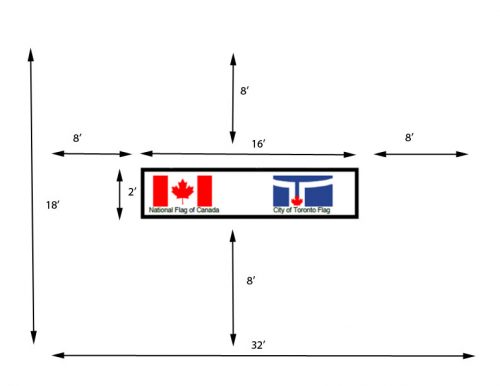
Flag raisings enhance public awareness of activities such as fundraising drives, multi-cultural events and national or independence days.
Flags may be lowered to half-mast to commemorate special dates such as Remembrance Day or as a measure of respect and condolence when a current public figure or former public office holder passes away.
Flags are used as a symbolic identification for countries, provinces, municipalities and organizations. The manner in which flags may be displayed in Canada is not governed by legislation, but rather by established practice which the City also observes.
Please review the criteria below and submit your flag raising request using our online request form.
Non-profit or charitable organizations may request for the City of Toronto to fly the following flags on its courtesy flag poles:
Please note:
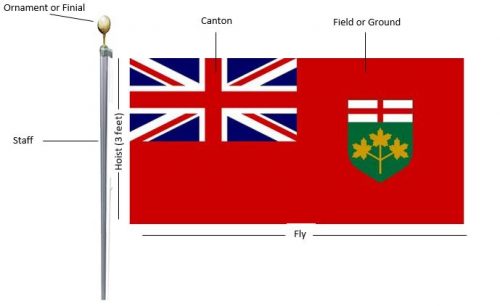
Toronto City Council does not approve individual flag raising requests. The City’s Chief of Protocol has delegated authority from City Council to approve these requests.
To request that a confirmed flag be taken down, City Council as a whole would need to change what was previously approved.
There are courtesy flag poles located at City Hall, Scarborough Civic Centre and North York Civic Centre.
Flags are half-masted at Toronto City Hall, Metro Hall and Civic Centres, generally from the time of death until sunset on the day of the funeral or memorial, unless other arrangements have been confirmed. Flags may also be lowered on the date of a funeral/memorial should it follow later.
Annual half masts include the National Commemorative Days.
The indigenous flags which are flown on Nathan Phillips Square include the symbols of the Mississaugas of the Credit First Nation, Haudenosaunee (Six Nations of the Grand River Territory), Huron-Wendat, as well as the Métis Nation and Inuit Tapiriit Kanatami.
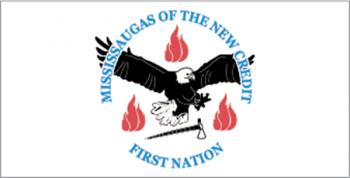
The Mississaugas of the Credit First Nation are a group of Ojibway (Anishinabe) belonging to the Algonquian linguistic group. The flag of the Mississaugas is based on their logo which includes five symbols of their history:
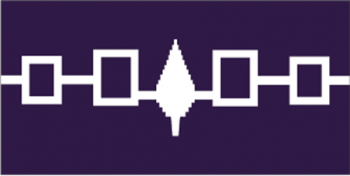
Six Nations (or Six Nations of the Grand River) is the largest First Nations reserve in Canada. These nations are the Mohawk, Cayuga, Onondaga, Oneida, Seneca and Tuscarora. Land was granted to the Six Nations by the 1784 Haldimand Treaty.
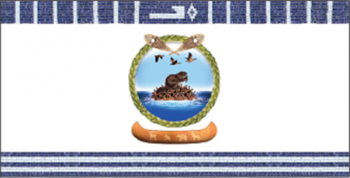
The Huron-Wendat Nation community and reserve is now found at Wendake, Quebec. The Huron Wendat Nation’s symbol represents its culture, territory and history. The symbol on the flag is accompanied by belts of wampum.

Prior to Confederation, a new Indigenous people emerged. From the initial offspring of Indigenous and European unions were individuals who simply possessed mixed ancestry. Subsequent intermarriages between these mixed ancestry children resulted in the genesis of a new Indigenous people with a distinct identity, culture and consciousness in west central North America – the Métis Nation.
This Métis people were connected through the highly-mobile fur trade network, seasonal rounds, extensive kinship connections and a collective identity through culture, language and way of life. Distinct Métis settlements emerged throughout what was then called “the Northwest”. In Ontario, historic Métis settlements emerged along the rivers and watersheds of the province, surrounding the Great Lakes and throughout to the northwest of the province.
The Métis flag is 200 years old. The current and most defining Métis flags consist of two variations – one that is blue and the other which is red. The Métis flag represents the Métis people with the infinity sign which symbolizes the immortality of the nation and the coming together of two distinct cultures: Indigenous and European and their existence forever as a people.
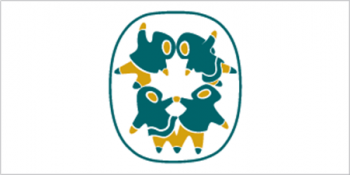
The Inuit Tapiriit Kanatami is the national organization for the Inuit who reside in four different areas in Canada. This includes Nunatsiavut in Labrador, Nunavik in Northern Quebec, Nunavut (a territory created in 1999), and the Inuvialuit Settlement area in the Northwest Territories and Yukon.
The depictions on the flag include the following:
In Canada, due consideration should be given to flag etiquette and precedence whenever the National Flag of Canada or other sovereign national flags or provincial/territorial flags are displayed.
Flags are symbols that identify and represent nations and although it may seem they provide a dignified and appealing backdrop, they are not intended as decor.
It is not proper protocol to fly the Canadian flag on the same pole as any other flag. According to the federal Department of Canadian Heritage, the Canadian flag should always be flown on its own mast. It should not be subjected to indignity or displayed in a position inferior to any other flag.
At Toronto City Hall, the Canadian flag flown is 7 ½ feet by 15 feet. On National Flag of Canada Day, Canada Day and other special celebratory occasions, the Canadian flag flown is 15 feet by 30 feet (weather depending). Flags flown at City Facilities should be appropriately proportionate to the height of the flagpole.
The location of the position of honour depends on the number of flags flown and the chosen configuration.
When two flags are displayed, the position of honour is furthest to the left (to an observer facing the display). If there are only two flags, the Canadian flag should be on the left and the City flag on the right from the perspective of the audience.


Figure 1: Displaying two flags. Canadian flag and a flag of a municipality
When three flags are flown, the position of honour is in the centre. From the perspective of the audience facing the flags, the Canadian flag should be placed in the centre, the Provincial flag on the left, and the City flag on the right.


Figure 2: Displaying three flags. Canadian flag, a provincial flag and flag of a municipality
![]()
Figure 3: Displaying more than three flags
Here is the order of importance of flags based on precedence:
Please use this guide to inspect flags monthly and replace when necessary. Toronto City Council (MM22.37) has requested a monthly inspection of flags at City facilities, including Agencies and Corporations.
Outdoor flags typically need to be replaced every three to four months. Various factors impact how often you must replace a flag, including location, weather, and/or continuous day and night display.
Flags should be retired and replaced when that flag’s condition is such that it is no longer a fitting emblem for display and should be destroyed in a dignified manner. Replace flags when they are:
City facilities should inspect all flags prior to National Flag of Canada Day (February 15), Canada Day (July 1st) and Remembrance Day (November 11th) each year.
View a printable Flag Care Checklist.
When a flag is no longer in a suitable condition for use, it should be destroyed in a dignified manner such as burning it in private.
Note
Flags flown at other civic locations vary depending on the number of poles but usually include one or more of the following:
Courtesy flag poles located at North York Civic Centre and Scarborough Civic Centre may fly flags permitted by the Flag Raising policy.
The recommended flag size to be flown is directly related to the height of the flag pole on which it will fly.
For more information please visit Rules for flying the National Flag of Canada.
Flag poles should be placed away from other structures, trees or other flag poles. The footprint around the base of the flag pole should be large enough to permit access to the poles as well as to allow for the space occupied by the largest size flag, plus a minimum of two feet (.6 metres) in each direction in order to pay proper respect to the flags displayed and ensure they will not get tangled. Equipment, such as signage, should not be placed at the bottom of the flagpoles to ensure there is access and no distraction from the flags.
Footprint example, two 20 ft. (6.1 metres) poles flying 3’ x 6’ (.9144 metres x 1.83 metres) flags side by side would need a minimum footprint of 32’ x 18’ (9.8 metres x 5.5 metres) as shown in the following diagram:
